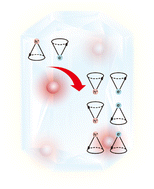Boosting organic room-temperature phosphorescence performance through joint luminescence sensitization†
Abstract
Organic ultralong room-temperature phosphorescence (OURTP) has broken through the traditional understanding of luminance from molecular aggregated structures of π-conjugated materials. However, it is still challenging to develop highly efficient OURTP molecules owing to their spin-forbidden intersystem crossing. Herein, we present a rational design to boost OURTP performance through luminescence sensitization involving multi-step energy transfer. With the weak OURTP molecule 9-phenyl-9H-carbazole as the host and metal complexes/thermally activated delayed fluorescence guests as triplet exciton activators, the bicomponent materials exhibit extraordinary OURTP performance with a lifetime of up to 455 ms and quantum efficiency of up to 14.5% as well as color-resolved emission under ambient conditions. Detailed photophysical characterization verified that the guests with facile intersystem crossing could promote the population of triplet excitons via luminescence sensitization, and the triplet excitons were stabilized by H-aggregation of the host, thus boosting OURTP performance.



 Please wait while we load your content...
Please wait while we load your content...